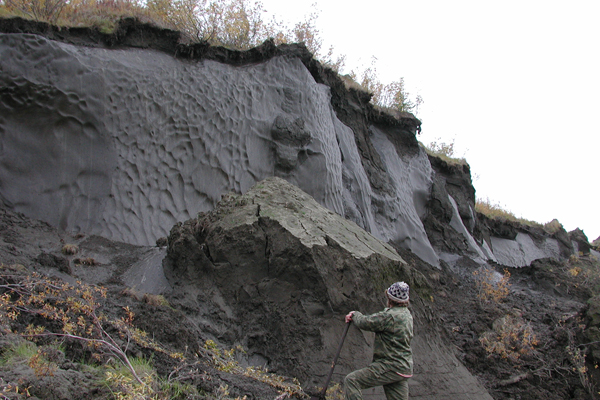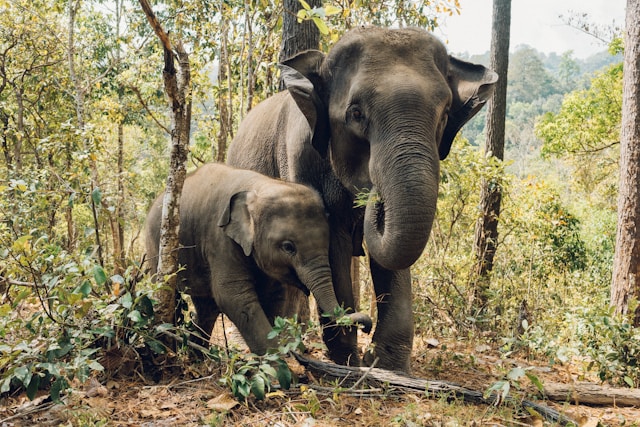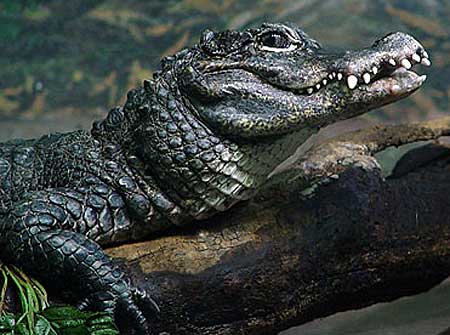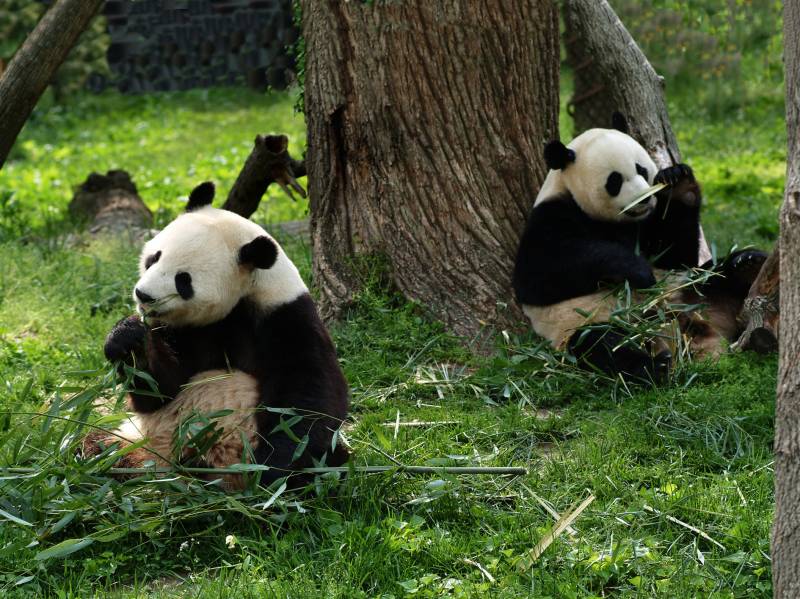
by Deep Green Resistance News Service | Feb 26, 2013 | Climate Change
By Jeremy Hance / Mongabay
While nations around the world have committed to keeping temperatures from rising 2 degrees Celsius (3.6 degrees Fahrenheit) above the pre-industrial era, new research published in Science suggests that the global climate could hit a tipping point at just 1.5 degrees Celsius (2.5 degrees Fahrenheit). Studying cave stalactites and stalagmites in Siberia, scientists found that at about 1.5 degrees Celsius the Siberian permafrost melts, potentially releasing a greenhouse gas bomb of 1,000 giga-tonnes, according to some experts.
Turning to cave formations—stalactites and stalagmites—to reconstruct past climates in Siberian Russia, the scientists found that Russia had little permafrost around 400,000 years ago when the world was about 1.5 degrees warmer than the past 10,000 years (or the length of human civilization).
“The stalactites and stalagmites from these caves are a way of looking back in time to see how warm periods similar to our modern climate affect how far permafrost extends across Siberia,” lead author Anton Vaks of Oxford University’s Department of Earth Sciences explains. The stalactites and stalagmites do not grow under permafrost conditions, but only when ice melt or rain is available. Therefore these cave formations act as signals for what past climate looked like.
According to the study, the only time the permafrost melted in the last half million years was between 424,000 and 374,000 years ago when temperatures globally hit the 1.5 degree Celsius mark. So far global temperatures have risen 0.8 degrees Celsius (1.4 degrees Fahrenheit) in just the last two hundred or so years with two thirds of that rise coming since 1980.
“As permafrost covers 24 percent of the land surface of the Northern hemisphere significant thawing could affect vast areas and release giga-tonnes of carbon,” Vaks says. Once permafrost melts, sunlight and bacteria will attack previously-frozen plant material, releasing carbon and methane into the atmosphere. Though at this point there is considerable debate about how much greenhouse gas emissions would actually hit the atmosphere.
Despite such concerns, experts say that reaching, and surpassing, 1.5 degrees Celsius is practically inevitable given that global greenhouse gas emissions continue to rise year-after-year. Many emissions are considered “locked-in” since fossil fuel-driven power plants have already been built or are currently being constructed. Still, many vulnerable and island nations have called on the global target to be reduced from 2 degrees Celsius to 1.5 degrees. But even making the 2 degree target is looking increasingly unlikely, unless, perhaps, scientists literally start pulling carbon out of the atmosphere or the world’s fossil fuel plants are shut-down.
Whatever comes, the experts say it’s time to start incorporating permafrost melt into current climate models.
Read more at Mongabay: “Rise in 1.5 degrees Celsius likely to spark massive greenhouse gas release from permafrost“
by Deep Green Resistance News Service | Feb 25, 2013 | Agriculture, Biodiversity & Habitat Destruction
By Jeremy Hance / Mongabay
Industrial oil palm plantations are spreading from Malaysia and Indonesia to the Congo raising fears about deforestation and social conflict.
A new report by The Rainforest Foundation UK (RFUK), dramatically entitled The Seeds of Destruction, announces that new palm oil plantations in the Congo rainforest will soon increase fivefold to half a million hectares, an area nearly the size of Delaware. But conservationists warn that by ignoring the lessons of palm oil in Southeast Asia, this trend could be disastrous for the region’s forests, wildlife, and people.
“Governments of Congo Basin countries have handed out vast tracts of rainforest for the development of palm oil with apparently little or no attention to the likely impacts on the environment or on people dependent on the forest,” Simon Counsell, Executive Director of the Rainforest Foundation UK, said.
The palm tree used to produce palm oil originated in Africa, so production in the Congo Basin isn’t new. But industrial palm oil production involving massive plantations is a recent development for the region. The approach, modeled after operations in Southeast Asia, raises concerns among environmentalists who argue that palm oil has been a disaster for the forests of Malaysia and Indonesia. Indeed, scientific research has found that between 1990 and 2000, 86 percent of all deforestation in Malaysia was for palm oil.
The largest palm oil developer in the Congo Basin is currently Malaysian-owned Atama Plantations SARL, which is working to establish a 180,000-hectare (450,000-acre) plantation in the Republic of Congo. But the entire enterprise is masked by a complete lack of transparency, says the report.
“No publicly available maps of the concession are available, but evidence suggests that the forests designated for clearance mostly appear to be virgin rainforest that is habitat for numerous endangered species, including chimpanzees and gorillas. The area borders, and some of it may fall inside, a planned National Park and Ramsar site,” according to the RFUK report, which notes that logging has already begun on the concession.
The RFUK report further questions whether the plantation development is simply an excuse to log what it calls “primary forests with significant timber stocks.”
Another controversial concession, this time in Cameroon, has received considerable pushback from international NGOs as well as local groups. U.S.-based Herakles Farms is working to develop a 60,000 hectare palm oil plantation in forest bordering four protected areas, but the company’s reputation has been tarnished by local protests, as well as condemnation from international groups such as Greenpeace. Last year, 11 top tropical biologists sent an open letter to Herakles condemning the project.
But Herakles and other companies say they are bringing economic development to a notoriously poor part of the world.
The RFUK report notes that in many cases governments appear unwilling even to take advantage of the economic benefits of palm oil plantations, by overly-sweetening deals to foreign corporations.
“The contracts signed between governments and oil palm developers are being kept secret, reducing transparency and democratic accountability. Those contracts that have come to light show that governments have already signed away some of the potential economic benefits, by granting developers extremely generous tax breaks of 10 to 16 years and land for ‘free’ or at highly discounted rates,” the report reads.
In addition, the palm oil plantations are sparking local conflict with traditional landowners, much as they have done in Malaysia and Indonesia. Locals often have little input on the project and in some cases leases are extraordinarily long, for example Herakles Farms’ lease is 99 years.
“New large-scale oil palm developments are a major threat for communities, livelihoods and biodiversity in the Congo Basin,” Samuel Nguiffo, Director of the Center for Environment and Development (CED), Cameroon, said. “It is absolutely not the appropriate answer to the food security and job creation challenges the countries are facing. Supporting small-scale family agriculture is a better solution.”
by Deep Green Resistance News Service | Feb 24, 2013 | Biodiversity & Habitat Destruction, Climate Change
By Andrew Gilligan / The Telegraph
Thousands of Britain’s wind turbines will create more greenhouse gases than they save, according to potentially devastating scientific research to be published later this year.
The finding, which threatens the entire rationale of the onshore wind farm industry, will be made by Scottish government-funded researchers who devised the standard method used by developers to calculate “carbon payback time” for wind farms on peat soils.
Wind farms are typically built on upland sites, where peat soil is common. In Scotland alone, two thirds of all planned onshore wind development is on peatland. England and Wales also have large numbers of current or proposed peatland wind farms.
But peat is also a massive store of carbon, described as Europe’s equivalent of the tropical rainforest. Peat bogs contain and absorb carbon in the same way as trees and plants — but in much higher quantities.
British peatland stores at least 3.2 billion tons of carbon, making it by far the country’s most important carbon sink and among the most important in the world.
Wind farms, and the miles of new roads and tracks needed to service them, damage or destroy the peat and cause significant loss of carbon to the atmosphere, where it contributes to climate change.
Writing in the scientific journal Nature, the scientists, Dr Jo Smith, Dr Dali Nayak and Prof Pete Smith, of Aberdeen University, say: “We contend that wind farms on peatlands will probably not reduce emissions …we suggest that the construction of wind farms on non-degraded peats should always be avoided.”
Dr Nayak told The Telegraph: “Our full paper is not yet published, but we should definitely be worried about this. If the peatland is already degraded, there is no problem. But if it is in good condition, we should avoid it.”
Another peat scientist, Richard Lindsay of the University of East London, said: “If we are concerned about CO2, we shouldn’t be worrying first about the rainforests, we should be worrying about peatlands.
“The world’s peatlands have four times the amount of carbon than all the world’s rainforests. But they are a Cinderella habitat, completely invisible to decision- makers.”
One typical large peat site just approved in southern Scotland, the Kilgallioch wind farm, includes 43 miles of roads and tracks. Peat only retains its carbon if it is moist, but the roads and tracks block the passage of the water.
The wind industry insists that it increasingly builds “floating roads,” where rock is piled on a textile surface without disturbing the peat underneath.
But Mr Lindsay said: “Peat has less solids in it than milk. The roads inevitably sink, that then causes huge areas of peatland to dry out and the carbon is released.”
Mr Lindsay said that more than half of all British onshore wind development, current and planned, is on peat soils.
In 2011 the Scottish government’s nature protection body, Scottish Natural Heritage, said 67 per cent of planned onshore wind development in Scotland would be on peatland.
Read more from The Telegraph: http://www.telegraph.co.uk/earth/energy/windpower/9889882/Wind-farms-will-create-more-carbon-dioxide-say-scientists.html

by Deep Green Resistance News Service | Feb 20, 2013 | Agriculture, Biodiversity & Habitat Destruction, NEWS
By Jeremy Hance / Mongabay
A biofuel plantation near Yala National Park has landed Lanka Orex Leasing Company PLC (LOLC) in Sri Lanka’s highest court. Environmentalists say the company is illegally bulldozing Asian elephant habitat, including scrubland and tree stands, near the buffer zone of Yala National Park for gliricidia (Gliricidia sepium) biofuel plantation.
“This is going to be a permanent cultivation within the home range of few elephant herds,” Vimukthi Weeratunga, Environmental Foundation Limited (EFL)’s head of operations and environmental scientist, told mongabay.com. “When we take the elephant land by developing this area, elephants will move to nearby villages to raid crop as they cannot use this area for their normal activities. This is exactly the way that human-elephant conflict increased in the other parts of Sri Lanka.”
Located near the buffer zone of Yala National Park, Weetatunga states that company never conducted an environmental impact assessment (EIA), transgressing Sri Lankan law. In addition, the Sri Lanka’s Forest Department has repeatedly denied leasing the land to the company in local press, instead it gave 500 hectares (1,250 acres) to local dairy farmers for rearing cattle. Lanka Orex Leasing Company PLC was merely supposed to provide “technical assistance” to the farmers.
The site in question is currently used by smallscale farmers for cattle and farming, but Weetatunga says that this doesn’t mean the ecosystem is degraded. Instead, he says smallscale farming and livestock in the area are actually important for elephants as opposed to a monoculture plantation.
“Shifting cultivation is a traditional farming practice by clearing some scrubland and leave after the harvest for forest to re-grow. This practice is ideal for elephants to thrive as they get high quality fodder after people leave to regrow,” he explains. Between 2,000 and 4,500 Asian elephants (Elephas maximus) roam Sri Lanka’s forests. The species is currently listed as Endangered by the IUCN Red List.
The area in question is home to many other species as well, including leopards, fishing cats, sloth bears, pangolins, and a large variety of birds.
Many have noted in Sri Lankan press the irony of destroying elephant habitat, including forest lands, for so-called green energy made from biofuels. Gliricidia is a woody plant that can be burned in a biofuel power plant.
The Environmental Foundation Limited (EFL) is currently awaiting a court date next month with Lanka Orex Leasing Company over the habitat clearing.
“We are asking [for an] injunction of current activities,” Weetatunga says. “We are also seeking compensation for their action if we win the case.”
Last year, environmentalists in Sri Lanka caught U.S. food giant Dole clearing forest in Somawathiya National Park for a banana plantation. Dole denied it was inside the park for months, but finally abandoned the project after threat of lawsuit.
Like many Southeast Asian countries, Sri Lankan is currently undergoing a tension between large-scale industrial projects, such as monoculture plantations, and local farming and conservation efforts.

by Deep Green Resistance News Service | Feb 14, 2013 | Agriculture, Biodiversity & Habitat Destruction
By John Vidal / The Guardian
Nearly one in five of the world’s estimated 10,000 species of lizards, snakes, turtles, crocodiles and other reptiles are threatened with extinction, according to a study conducted by 200 experts.
But the risk of extinction was found to be unevenly spread throughout the extremely diverse group of animals. According to the paper, an alarming 50% of all freshwater turtles are close to extinction, possibly because they are traded on international markets.
The study, published by the Zoological Society of London in conjunction with the IUCN species survival commission, is the first of its kind summarising the global conservation status of reptiles, and used 1,500 randomly selected reptiles worldwide.
Out of the estimated 19% of reptiles threatened with extinction, in order of magnitude of danger, 12% are classified as critically endangered, 41% endangered and 47% vulnerable.
Three species were found to be possibly extinct. One, a jungle runner lizard, Ameiva vittata, has only ever been recorded in one part of Bolivia. In Haiti, six of the nine species of anolis lizard included in this study have an elevated risk of extinction, due to extensive deforestation affecting the country.
The spread of farming and deforestation in tropical regions represents two of the greatest threats to reptiles, says the paper.
Read more from The Guardian: http://www.guardian.co.uk/environment/2013/feb/15/reptile-species-face-extinction

by Deep Green Resistance News Service | Feb 10, 2013 | Biodiversity & Habitat Destruction
By Mongabay
China’s decision to open up collective forest for sale by individuals to outside interests will put 345,700 hectares or 15 percent of the giant panda’s remaining habitat at risk, warns a letter published in the journal Science.
The letter, authored by a team of researchers including scientists from Conservation International and Chinese institutions, says that China’s land tenure reform will open key panda habitat to logging and conversion by allowing collectively-owned land to be transferred or leased to commercial enterprises. The letter cites a recent case where a timber company purchased 15,000 ha of forest in Chongqing Province.
“This change puts these vital habitats potentially under threat from commercial logging, increased collection of firewood and non-timber forest products by outside enterprises, and other commercial development activities,” said co-author Russell Mittermeier, a biologist who serves as President of Conservation International (CI), in a statement. “Sadly, it would threaten to deforest, degrade or disturb up to 15% of the remaining giant panda habitat.”
“The reform contradicts the great steps the Chinese government has taken to conserve the giant panda in recent decades,” added Li Zhang, a scientist with Conservation International China. “The government has designated 63 panda reserves which constitute over 60% of the panda’s remaining wild habitat, improved the species’ endangered habitats by reforesting or restoring native forests and restricting human access to these, increased the number and capacity of forestry staff in these areas, strictly banned hunting of the species, and pioneered captive breeding techniques. As a result of these efforts, the official number of giant pandas in the wild has increased to nearly 1,600 from less than 1,000 in the late 1980s. It would be inexcusable to reverse this great achievement for these majestic creatures and our country’s recent conservation efforts.”
The giant panda is classified as critically endangered on the IUCN Red List due to habitat loss and hunting. The species has been driven to extinction in Vietnam and Myanmar. In China it’s habitat — old growth forests — has fallen by roughly 60 percent since 1950.




